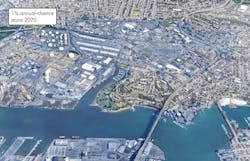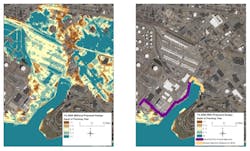The cities of Chelsea and Everett, Mass. are diverse, densely-settled urban communities across the Mystic River. Highly vulnerable to flooding, the majority of each city is designated as an environmental justice community and as such is disproportionately exposed to the effects of climate change.
Both cities border the Island End River, a saltwater tributary of Boston Harbor. Once an extensive salt marsh, the river was culverted, and the surrounding area filled in and paved, between the 1800s and 1960s. The surrounding developed area is the region’s largest food distribution cluster, and it supports multiple regional infrastructure facilities and critical industrial users, including the New England Produce Center, the primary source of imported fresh produce for New England, and the Canadian Maritimes. It also houses Greater Boston’s only onshore liquid natural gas (LNG) terminal, the Mass Information Technology Center, regional FBI headquarters, the City of Chelsea’s High School and Middle School, regional public transit lines, and multiple Federal Highway Association-designated “Critical Urban Freight Corridors” serving the Lower Mystic Designated Port Area (DPA). In total, the area provides 11,000 jobs and helps generate over $4 billion annually in economic activity.
Because of its topography and hydrology, however, the entire Island End River district is vulnerable to flooding, with low-lying areas along the river’s original pathway experiencing frequent coastal and stormwater flooding.
Weighing Options
One option to reduce coastal and stormwater flooding in the area would be through potential retreat strategies. However, more than a century of industrial development, combined with dense, critical, regional infrastructure and exploding development pressures, makes a divestment from infrastructure too challenging.
After decades of escalating flood issues, the cities of Chelsea and Everett came together in 2016 to consider a regional approach to coastal storm flood resilience at Island End. The collaboration, named the Island End River flood resilience program, involved engineers and consultants at Weston & Sampson, AECOM, Tetra Tech and its planning subsidiary Fort Point Associates, Dewberry, Woods Hole Group, One Architecture, and others.
To develop an effective program that could help build resilience, the program team assessed the best available climate science and modeling, considered ways to adapt infrastructure and land uses, and then explored possible mitigation measures.
Alongside each possible approach, the team considered opportunities for community co-benefit. This incremental program development also received input from an extensive community and stakeholder engagement program supported by the Mystic River Watershed Association and GreenRoots, a local environmental justice organization.
The decision was made to proceed with a “systems-based approach” to district flood resilience. This approach included berms, floodwalls, wetland improvements, coastal bank improvements, gates for rail and road crossings, and a culvert with a storm surge outlet control facility. The team sought to pair nature-based solutions with barrier types strategically fit to the varied land profiles in the flood pathway.
The eastern (Chelsea) side of the project was designed for a hybrid barrier composed of earth and lightweight aggregate fills, driven steel sheet pile to provide seepage barrier and structural support, and architecturally finished formed concrete cap for aesthetics. The western (Everett) portion of the flood pathway was designed for the adaptation of existing waterfront bulkheads and for the construction of additional walls to comply with maritime industry requirements in the Mystic River Designated Port Area (DPA).
An alternatives analysis evaluated the precise location and composition of flood control features. The project team studied each prospective segment of the barrier, berm, and storm surge control structure separately to tailor a composition of construction, location, and height requirements. The project team worked with over a dozen property owners to fit surface features to the property owners’ land use needs.
The program was required to deliver effective flood mitigation — through nature-based solutions where practical — while maximizing the living shoreline and improving abutting water resource areas. Simultaneously, the project needed to provide a continuous community waterfront path with new open space access, maintain critical infrastructure in the area, and respect the interests of nearby landowners, industry, and the DPA.
Outside of the DPA, the project’s riverwalk and wetland improvements vision will deliver functional public access to the shoreline and new community recreational space. The new riverwalk will open accessibility to the existing City of Chelsea Island End Park site, which had been inaccessible from the public right-of-way, and it will expand the existing network of riverwalk paths in the Mary O’Malley State Park. The riverwalk systems will additionally serve to taper, slope, and integrate the elevated resilience features with the surrounding public and private environments. The new riverwalk spaces will be richly planted to develop tree canopy and help mitigate urban heat island effect, which is a concern in this densely-developed district.
Surge Control Needs
The push for district flood resilience also drove a careful re-assessment of the region’s stormwater system hydrology and hydraulics. The cities built a model which integrated their stormwater systems, simulated the model under future sea level rise/storm surge and extreme rainfall scenarios, and interpreted results to find vulnerabilities and evaluate flood mitigation alternatives.
The assessment helped determine that a storm surge control system was required over the larger diameter culvert pipes at the river’s outlet. These 10’x15’ and 6’x9’ culverts had been unprotected from tidal surges and were a conduit for coastal storm flooding to inland areas.
Traditional passive tide gates were not acceptable at this location because tidal wetlands were located upgradient of the 10’x15’ culvert. The program developed a plan for a new 43’ x 57’ storm surge control structure designed to pass regular tidal flows but block coastal storm surge at a set elevation before it would result in significant flooding. The communities also began strategically pursuing in-line check valves in the collection system to further bolster localized flood protection.
The Risk of Freshwater Flooding
While coastal storm surge was recognized as the greatest risk to the district, the communities also reviewed risk from rainfall-induced piped infrastructure flooding that would persist even after coastal flood resilience features was constructed. The risk would bring freshwater flooding via surcharge of the stormwater collection system when it could not discharge to the harbor during periods of higher coastal tailwater elevations.
This risk was studied in the integrated stormwater system model with future coastal storm events as boundary conditions. The results, analyzed for different storm scenarios and assessed for vulnerability, will drive improvements in the municipal collection systems, which may include conveyance capacity improvements, addition of floodplain storage, and supplemental pumping systems.
Looking Ahead
The program has been supported by Massachusetts Coastal Zone Management’s Coastal Resilience Grant program and the Executive Office of Energy and Environmental Affairs’ Municipal Vulnerability Preparedness Grant program, alongside significant investment of local resources. The communities were also awarded a Federal Emergency Management Agency (FEMA) Hazard Mitigation Assistance Pre-Disaster Mitigation grant, as well as a Building Resilient Infrastructure and Communities (BRIC) Capability and Capacity Building grant.
The cities are currently preparing to pursue construction funding opportunities. They see the best opportunity through FEMA’s BRIC program, which offers up to $50 million for eligible projects. The cities have a benefit cost analysis using FEMA’s prescribed methodology, which illustrates the high value that the program could provide for the community. The scope of the grant construction program will include systems required to mitigate against damaging coastal storm flooding — but it will defer to future capital projects stormwater hydraulics improvements oriented around mitigation of piped infrastructure flooding from extreme rainfall.
Performance modeling of the proposed improvements using the best available modeling (Massachusetts Coast Flood Risk Model) suggested that the proposed systems will effectively mitigate coastal storm surge flood risk for up to the 1 percent probability event in 2050, which otherwise would impact approximately 300 acres of land in Chelsea and 200 acres of land in Everett. To mitigate coastal storm surge flood risk for the 1 percent probability event in 2070 and beyond, other regional flood resiliency projects would be required to prevent flanking of the system.
Chelsea and Everett are founding members of a 20-municipality voluntary partnership called the Resilient Mystic Collaborative (RMC), which works to coordinate communities around regional climate resilience projects. They worked with other municipal engineers in the RMC to validate the significance of the Island End River program in the context of the broader regional climate resilience framework. This review suggests Island End River resilience must coordinate with work in Boston and the Massachusetts Department of Conservation and Recreation’s resiliency works at and around the nearby Amelia Earhart Dam to provide long-term flood resilience for the Upper Mystic River watershed.
Published in Stormwater magazine, November 2022.
About the Author
Timothy Corrigan
Tim Corrigan, P.E., is an associate and team leader at Weston & Sampson. He specializes in the evaluation, design, and permitting of water distribution, as well as wastewater collection and stormwater collection system improvements.





